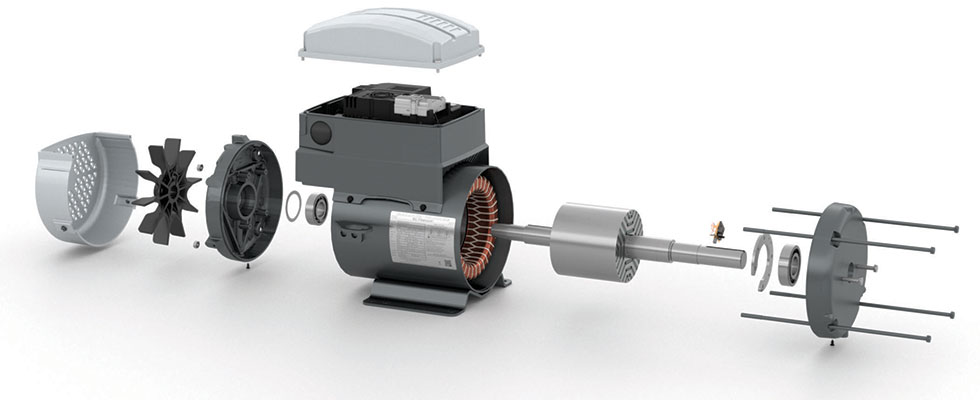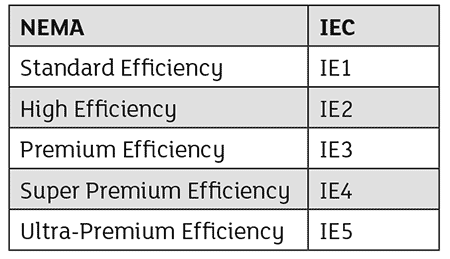
Electric motors consume more than one-third of the world’s energy, and the number of motors in operation is expected to double by 2040. In the United States, pumps are responsible for 40% of the total industrial motor system’s electricity consumption. Motor standards have been in place for decades; yet, there is a growing demand to achieve greater efficiencies as the International Electrotechnical Commission (IEC) continues to investigate new standards on wire-to-water and wire-to-air efficiency. In response, equipment manufacturers are turning to new motor technologies to achieve the highest system efficiency possible.
To reach a greater level of efficiency, OEMs and end users are moving from standard induction motors, which meet IE3 (premium efficiency) standards, to synchronous reluctance or electronically commutated (EC) motors, both of which meet the IE4 (super premium efficiency) level. But, while many regulatory bodies are requiring manufacturers to comply with IE4 standards by 2023, even tighter regulations are already on the horizon.

The next update of IEC standards will introduce the IE5 class, which is being referred to as ultra-premium efficiency in North America. Motor losses are reduced by 10% per IEC efficiency class, which results in IE4 and IE5 motors delivering 5% to 15% energy savings in comparison to IE2 and IE3 designs. A target date for manufacturers to reach ultra-premium efficiency level has not yet been identified; however, the next generation of synchronous reluctance electric motors developed to meet or exceed upcoming IE5 standards is already available.
A ferrite-assisted synchronous reluctance motor is based on induction motor technology and operates on the same principle for rotation. It uses a standard stator and wiring; the difference lies in the addition of ferrite magnets to the rotor. Ferrites are ceramic magnets made by combining iron oxide with other materials. They add to torque generation and field strength of the rotor without requiring an electrical current. This less-work stator experiences lower losses overall, which means higher efficiency. The result is a stator that supplies torque on demand, allowing for optimization of current and higher efficiency at partial loads.
Unlike induction motors, ferrite-assisted synchronous motors are suitable for constant and variable torque applications and offer excellent performance across a wide speed load range, including the lower speeds and load points often run by pump systems. Ferrite-assisted synchronous reluctance motors do not suffer from the losses normally associated with induction solid rotors, and they provide a broader peak operating range compared to synchronous reluctance and EC motors. The motor design requires less amperage per horsepower than induction due to the high 92% to 98% power factor. This allows for a smaller power converter and a motor that will run as much as 20% cooler.

In addition to the efficiency of the motor, whole system (wire-to-water) efficiency is increased by allowing pumping facilities to select a pump design with the highest efficiency and fit of the motor to this curve, establishing the motor as the constant in the efficiency equation.
The near unity power factor of the ferrite-assisted synchronous motor enables the use of a smaller variable frequency drive, reducing the footprint and weight of the integrated system. For pump lines with limited space, this configuration saves control panel space and reduces wiring costs by placing the drive on top of or on the opposite drive end of the motor. And, many ferrite-assisted synchronous motors are designed around standard NEMA mounting dimensions, keeping installation and retrofitting costs minimal.
Finally, ferrite-assisted synchronous motors provide an environmental and economical alternative to motors relying on rare-earth magnets, which are difficult to source, more expensive, subject to market fluctuations and can produce toxic byproducts. Ferrite magnets are manufactured using abundantly available materials (ceramic ferrites), produce less waste and can be sourced at a lower cost.
Pumping operations looking to add new lines or upgrade existing lines may want to consider ferrite-assisted synchronous motors now to get ahead of upcoming government efficiency requirements, maximize available space, meet environmental sustainability goals and gain an early competitive advantage.

